Global warming mobilisation and 21st century Liberty ships


Curiously Un-Iconic: Despite killing between three and six times as many people as the world war that had just ended, the 1918 Pandemic is rarely mentioned in the mainstream media. US Army photographer
As a metaphor, the rms Titanic eclipses the First World War.
In turn, World War One eclipses the 1918 Pandemic, which claimed possibly six times as many lives than ‘the war to end war’.
The classic Titanic message is that the world’s largest ship, hyped as unsinkable, put to sea with insufficient lifeboats, and insufficient preparation to deploy those she carried. And when advised of dangers ahead, pride overrode prudence and she struck her hazard at close to full speed. If the RMS Titanic is a metaphor for Earth’s collision with climate, then the lookout has long since warned the bridge:
Iceberg right ahead.
But the quartermaster has yet to receive any instruction, and the ship’s telegraph remains un-rung.
The manoeuvre that the SS Earth should be attempting is that which might just have saved the RMS Titanic—helm hard over, main and starboard engines full ahead, port engine full astern. While a crash turn might have resulted in the ship clearing the iceberg, tragically for the compliment of the SS Earth, there is no hypothetical manoeuvre that will leave the ship unscathed; she simply has too much way on when steaming in berg-infested waters, and she has four times as many passengers and crew for the lifeboats she is carrying.
During her sea trials, with her port and starboard engines full astern—her main engine, being a turbine, was not reversible—the RMS Titanic performed a crash stop in a little less than three times her own length. However, the iceberg that was her undoing may have been less than one her 269-metre lengths away when sighted. Meantime the SS Californian, much-maligned for failing to go the aid of the ship she’d earlier warned, was hoved-to for the night after an iceberg brought her to an abrupt stop.
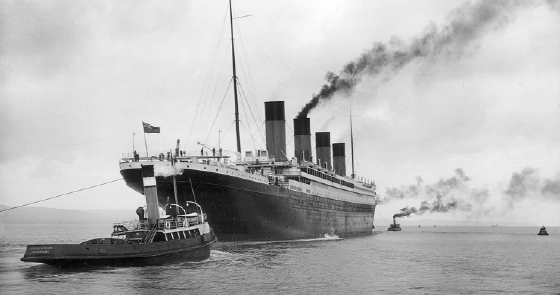
Icon for the Unstoppable: During her sea trials, steaming at 20 knots, with the helm hard over the RMS Titanic was able to turn in a 3.5-kilometre diameter circle. The industrialised world doesn’t have that much sea room in which to turn, certainly not while pouring forth carbon dioxide at close to maximum output. image Wikipedia
The innumerable books written on the subject of anthropogenic global warming in recent decades invariably include a determinedly upbeat section designed to reassure readers that, as dire as the prospects may be for slowing climate change and mitigating its worst impacts, the situation is far from hopeless—so long as there is immediate action. The world’s most maligned, yet utterly vindicated, climate scientist, Michael E Mann concludes his just published The Hockey Stick and the Climate Wars referencing Jared Diamond’s iconic Easter Island analogy:
The problem is less intuitive for global environmental problems, as the global commons illusively appear infinite. Not only are our land and seas finite, but so too is our atmosphere, and our practices are changing its composition detectably and profoundly. Ending those practices will require extraordinary cooperation across the governments and peoples of the world. But like Diamond, I’m cautiously optimistic that we will meet the challenge.
But the industrial world is as close to full speed as its ‘recovering’ economy permits. The passengers, rather than being content with the prospect of a good night’s sleep, should take the climate scientists’ lead and storm the bridge to demand the ship heave-to immediately.

Much-Maligned Icon: Despite drawing the wrath of global fossil fuel interests and an army of their paid and unpaid stooges, and the merely misinformed, the hockey stick –shaped record graph of global temperature, with its sharply ominous upswing forming the blade, has been vindicated and reinforced by every reputable piece of science since. Ironically, Michael E Mann, the target of an orchestrated avalanche of invective, initially studied natural climate variation and was deeply sceptical about anthropogenic influence. chart IPCC Third Assessment Report
In two years time it will be the centennial of the outbreak of the First World War that will be dominating the attention of essayists. With its death toll of 16.6 million—far more exactly quantified than that of the 1918 Pandemic—the avoidability of that carnage will be endlessly discussed. With the population of planet Earth powering past seven billion, and with the possible long-term sustainable level being one and a half to two, there is a criminal shortage of lifeboats. This makes it probable that global warming casualties will dwarf those of both world wars and the pandemic, as a sharply reduced ability to feed, cloth and shelter humanity impacts with a population looking to double. While the misanthropic might feel mankind deserves such a fate, the blameless natural world is already experiencing geological-scale species extinction rates, with Aotearoa contributing disproportionately.
As awful and as avoidable as they were, the world wars demonstrated how entire countries, and allied groups of countries, could mobilise against a common foe. Production-line shipbuilding, perfected by the Liberty ship programme, launched the equivalent of 738 Titanics. Quaintly, the British specifications for the first of these called for riveted, rather than welded construction. Rivets, and inferior rivets at that, contributed to the RMS Titanic’s demise, thanks to a double row of them popping as her plates were buckled by the berg’s long glancing blow.
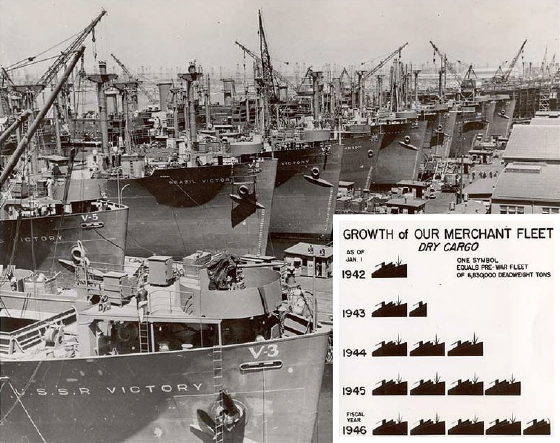
Icon for Victory: In addition to 2710 Liberty ships, the United States built 534 of the stronger, faster and rather better looking Victory class merchant vessels. Nevertheless, the Liberty ship—the bow of one is fifth from the camera—remained the enduring icon for the war effort. image War Shipping Administration
Schemes for a new green, typically American-led, economy to lead the world out of the iceberg field are a theme common to most books on the topic of global warming. A given, invariably, is the free market, specifically one freed from manipulation by the oil oligarchy—if fossil fuel merchants were forced to pay for the damage being done to the atmosphere, a nice, renewable energy world would quickly prevail, or so the argument goes. Aside from the fact that there is much about renewable energy that is problematic, World War II was fought and won by (grand-coalition) governments making strategic decisions and the requisite appropriations. A total of 18 American shipyards were set to work building Liberty ships. Shipbuilders made a fortune, and workers earned high wages. There was never any ideological notion that the war effort would somehow happen by free market magic, such as by introducing some munitions trading scheme. If it had been left to free enterprise, instead of 2710 sturdy fit-for-service cargo ships sliding down the ways, a thousand Howard Hughes might have had nothing more strategically sound than the likes of the ‘Spruce Goose’ to tout to their governments.
The fiendishly inextricable fix that humanity has unwittingly got itself into is that its wealth is almost wholly thanks to free—excepting extraction, processing and distribution costs—fossil fuel. Regardless of how quickly population is reduced and average per capita energy use is scaled back, titanic amounts of replacement non-fossil-fuel energy are needed. Added to that is the formidable energy required to build the new non-fossil-energy infrastructure, and to relocate and rehouse, ultimately, billions.
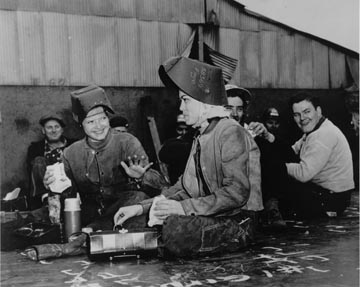
Rosie the Welder: At Permanente Metals Corporation No.2 Shipyard, which held the record for the shortest time to build one—four and a half days to build the SS Robert E Peary—and at the other Liberty shipyards, the welders were often women. Liberty ships were welded rather than riveted—the ‘Rosies’ who riveted typically did so building aircraft. image San Francisco State University
Only a Liberty ship –scale programme of building non– carbon dioxide emitting power plants will allow a crash‑stop of the world’s coal, oil and gas-fired generators. Since 1988, atmospheric carbon dioxide levels have increased by 40 parts per million to nearly 400, as compared to the pre– industrial era level of about 280. A crash stop demands putting the engines in reverse. Simply throttling back a little will still see temperatures rise to render significant regions unproductive and uninhabitable. Instead, aside from a slight dampening effect from the global economic downturn, there has been no letup in emissions—the boilers continue to be stoked as though there are totally clear seas ahead.
A latter-day Liberty ship project is about to be launched by the United States Department of Energy. The initiative will help the private sector to design and commercialise factory-built small modular reactors, which are urgently needed to replace the ruinously carbon dioxide-emitting coal-fired generators that are the norm in much of the developed world, and being built like there’s no tomorrow in the developing one. While each unit is only rated at a little more that a sixth of the Huntly Power Station, they can be sited closer to where the power is consumed and so can greatly reduce transmission costs. That it has taken an energy secretary appointed by a Democratic Party president, Nobel Prize –winning physicist Stephen Chu, to kick-start the modern American nuclear industry is instructive:
The Obama Administration and the Energy Department are committed to an all-of-the-above energy strategy that develops every source of American energy, including nuclear power, and strengthens our competitive edge in the global clean energy race.
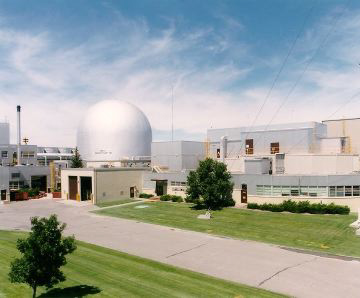
Fallen Icon: Once the promise of limitless, cheap energy, nuclear power carried the baggage of Hiroshima and Nagasaki, and a seemly intractable radioactive waste issue, even before Chernobyl. Fourth generation technology decisively solved the waste and meltdown issues, only for the Clinton–Gore administration to shut it down to appease party anti-nuclear sentiment. Now a more rational administration is beginning to breath life into this best hope for planet Earth’s atmosphere. Argonne National Laboratory–West
An accurate measure of how well commentators understand the challenge of de-carbonising energy is the degree to which they acknowledge the imperative for nuclear power. But while the US$450 million funding for small modular reactors is a significant boost, to approach the heroic scale of the Liberty ship programme, the Department of Energy will need soon to be not just kick-starting the design and commercialisation of fourth generation designs, but to commission the building of a ‘fleet’ of them—President Barack Obama’s moon mission.
Fourth generation technology is the answer to the seemingly intractable issue of radioactive waste—elegantly addressed by burning the resource, which otherwise remains hazardous for thousands of years, as fuel. James Hansen, director of the NASA Goddard Institute for Space Studies, specifically supports the deployment of fourth generation nuclear. In 1988 Hansen delivered a blunt warning to congress:
Global warming has reached a level such that we can ascribe with a high degree of confidence a cause and effect relationship between the greenhouse effect and observed warming; it is already happening now.
Shamefully, the technology is still in the development phase, thanks to the well-advanced work on the integral fast reactor being torpedoed by the Clinton–Gore presidency, to appease the Democratic Party’s determinedly anti-nuclear voters. Not only did this condemn the atmosphere to receive vastly more carbon dioxide, it also inflicted higher levels of radiation on the populace. The anti-nuclear lobby turns a determinedly blind eye to the higher levels of radiation that coal-fired generators routinely release, than do nuclear plants:
In fact, the fly ash emitted by a power plant—a by-product from burning coal for electricity—carries into the surrounding environment 100 times more radiation than a nuclear power plant producing the same amount of energy.
But the lack of a fourth generation programme isn’t call to condemn the funding the small modular reactor. Fourth generation is flagged on the department’s website as the future, and Professor Barry Brook believes that there is a perfect synergy between generation three and four technology that will result in the very efficient use of fuel, once the latter power plants, currently under advanced development only in Russia, come online. Professor Brook, presently in Russia as a member of the international awards committee for the Global Energy Prize is a highly cited researcher in the field of species extinction risk, including due to global warming. His advocacy for nuclear power is the result of an exhaustive examination of the limitations of other so-called clean energy sources.
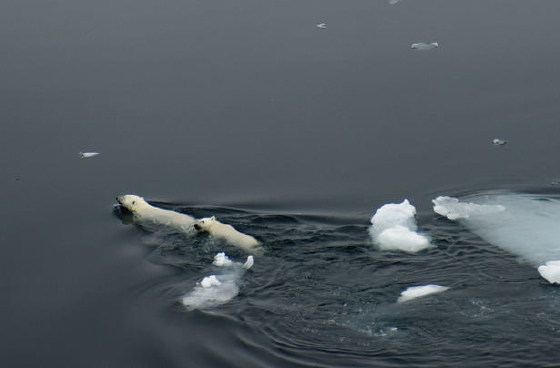
Thin Ice Right Ahead for Icon: On course for the Arctic summers to soon be ice-free, the iconic polar bear is feeling the pinch—the first aerial survey of Western Hudson Bay, carried out in 2011, sighted 701 individuals of which only 50 were cubs and 22 were yearlings. Undaunted, the climate denial mill claims that the survey shows more polar bears than were expected. photographer Paul Watson Toronto Star
The increasing awareness of anthropogenic global warming has added considerable weight to earlier movements centred on the concept of sustainability. But, dangerously, sustainability can encourage long‑term thinking at the neglect of the urgent. A crash stop in greenhouse gas emissions and in population is needed—World War II had to be won before work could commence on a sustainable peace. Sea-level rise requires that planning for relocating millions must begin—it certainly requires that cities at zero elevation that are levelled by earthquakes, be rebuilt on higher ground. The crippling cost of rebuilding Christchurch is a graphic taste of the astronomical cost to come of relocating the high percentage of world’s cities—established at sea level as port towns, in the sailing ship era. Equally importantly, large swaths of intensively cultivated land will be lost to food production, and not just through sea-level rise. Solar, tide and wind may yield sustainable energy, but the resources needed to have it replace fossil-fueled technologies, while forsaking nuclear, is ruinous, and in the meantime a quarter of world’s population waits for electricity.
The universal conviction of First World War veterans was that global war should never again be waged. Survivors of the unspeakable horrors of Gallipoli strongly resented being portrayed by politicians as heroes, and fervently believed that disagreements between nations must, from that time forth, be settled by discussion not warfare. But the time for discussion of the need for climate action has long since past—it is 24 years since the Hansen congressional hearings. Aotearoa has two clear duties in the war on warming. The first is to make the greatest nutritional contribution with the least greenhouse gas emissions, and the second is to put every last scrap of land to work growing trees to pull carbon dioxide out of the atmosphere. Her signature Liberty ship project should be to establish forestry, and preferably indigenous forestry, on the scale of the former New Zealand Forest Service. Anything that can be built with wood rather than concrete and steel is a win for the atmosphere—cement manufacture is responsible for 5% of carbon dioxide emissions, similar to the greenhouse gas contribution of livestock. Meantime, the longer a wooden product endures, the longer the carbon is sequestered. Shamefully, the commendable contribution that results from New Zealanders’ fondness for building wooden houses has been badly eroded by the post-1994 scourge of leaky, and thus prematurely short-lived, homes.

Connecting the Dots: Not daring to so much as mention climate change when reporting on extreme weather, such as that which killed this corn, the mainstream media resembles the RMS Titanic’s radio room, which sat on four warnings of the ice field the ship was charging through. Like the passengers who had noticed the ice for themselves, the American public is now gaining an appreciation that events such as the drought in Texas and Oklahoma in 2011, which cost US$10 billion in agricultural losses, are consistent with anthropogenic global warming. image Statesman Multimedia
The truly chilling Titanic metaphor is that of her radio room for today’s mainstream media. A Yale Project on Climate Change Communication survey has found:
A large majority of Americans believe that global warming made several high profile extreme weather events worse…
For more than two decades, climate scientists have consistently warned that anthropogenic global warming is bringing an increase in the frequency and severity of extreme weather events. But the mainstream media, rather than dare mention that a particular high profile weather event is consistent with climate change, keeps its head down lest the well-funded forces of denial unleash an orchestrated cacophony of derision, and threats to withdraw advertising. The RMS Titanic’s radio room received six warnings of drifting ice, which passengers had noticed on the afternoon of the collision. The first two reached the captain, but while a course adjustment was made, the ship continued to steam at within two knots of full speed. Ten hours before the fatal impact, the first of another four increasingly specific radio warnings were received, but failed to leave the radio room—the operators were blindly battling through a backlog of the passengers’ private messages that had resulted from equipment failure the previous day. This preoccupation with business-as-usual while the great ship ploughed into an ever-more dangerous ice field, is closely analogous to the world’s ships of state ploughing on while the mainstream media maintains the illusion of normalcy rather than rousing the world and its leaders to the clear and present danger.
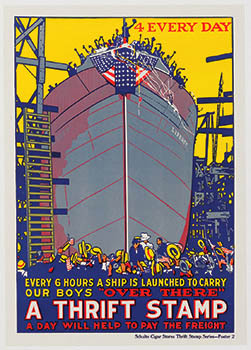
Mobilising the Masses: Thrift stamps encouraged invaluable buy-in to the First World War—the ship depicted here is the Liberty, rather than a Liberty ship—war effort, and returned the public 4% interest compounded quarterly, tax free. Financing the war on global warming with a similarly government-guaranteed scheme today might well be mobbed. image War Shipping Administration
For these Titanic metaphors to be apposite, the collision has already occurred—dangerous global warming is not something that might happen if greenhouse gas emissions continue unabated, it is already killing an estimated more than 300 000 per year. Six events alone in the United States between 2000 and 2009 exacted a US$14 billion toll in lost lives and healthcare costs. What is yet to be determined, and what cannot be quantified for centuries, is what the final toll will be. In the extreme scenario, the course that humanity is currently determinedly steering, involves going after every last skerrick of economically extractible fossil fuel. That, by Dr James Hansen’s calculations, would be sufficient to precipitate the unstoppable onset of the Venus syndrome, in which all water is boiled out of Earth’s oceans and atmosphere. But well short of that diabolical scenario, the estimates are still bleak:
…a global-mean warming of roughly 7°C would create small zones where metabolic heat dissipation would for the first time become impossible, calling into question their suitability for human habitation. A warming of 11–12°C would expand these zones to encompass most of today’s human population.
With the ship starting to take on water, every available resource must be mobilised—every day of unnecessary delay is unnecessarily condemning more lives and more species, and is shutting down options. Every last spare scrap of unproductive land should be growing a tree, even if that fate of the timber is to burned as biofuel. Rather than the staggeringly unstrategic $365 million extension to the Marsden Point oil refinery planned, Parliament should be making the appropriations necessary to build a world-leading industrial-scale torrefaction plant, on the volcanic plateau, to showcase Scion’s success in converting radiata pine waste into a fuel with the equivalent energy of coal.
Twenty-first century Liberty ships, not more Titanics.
